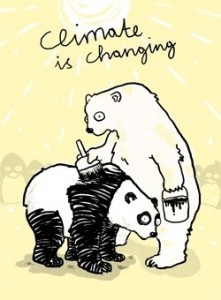UPDATE/ADD Below
Warm this late-afternoon Wednesday here in California’s Central Valley — near-about enjoyable outside with temperatures in the high 80s (after almost a month of triple-digit temps) as we catch our first break from hot-as-shit weather boiling through the summer. Although it’s gotten really hot the last few weeks hereabouts, it’s been nowhere nothing like, say, Phoenix, Arizona, which ended a historic heatwave on Monday — record 31 straight days of 110-plus-degree heat.
Shit sounds like crazy climate-change heat — duh!
Set aside just a second the horror of the illegal, lying, insurrection-inciting asshole of the T-Rump and the on-charging news of his heavy-duty criminal activity, with a somewhat quick reflection on another, maybe even way-worse venture — global warming:
Latest observations of global temperature change shown as a 'climate spiral' using monthly averages from January 1850 to June 2023.
Uses @metoffice HadCRUT5 dataset, representing change relative to the 1850-1900 'pre-industrial' era. pic.twitter.com/y5ax8tmlLq
— Ed Hawkins (@ed_hawkins) July 31, 2023
This summer has been an environmental wonder — via The Washington Post from Monday and this year’s wild weather of rain, heat, and the anguish of forest fires blowing off the extreme — weather anomalies:
“On the one hand, we knew these things were going to happen. These have been the predictions for a long time,” said Claudia Tebaldi, a scientist at the Pacific Northwest National Laboratory.
And yet, she said, “this year, in particular, has seemed so extreme. … The size of the anomalies is surprising.”
For years, climate scientists have detailed again and again the many impacts that are likely as the world grows steadily hotter, such as more intense storms, more torrential rainfall, fast-rising seas and melting ice caps.
But they also have been unequivocal that with more warming comes the possibility of unforeseen consequences — of rapid changes, irreversible collapses and other feedback loops.
More than a decade ago, a study from the National Academies of Sciences, Engineering and Medicine found that while many aspects of climate change and its effects “are expected to be approximately linear and gradual,” that won’t always be the case.
“It is clear that the risk of surprises can be expected to increase with the duration and magnitude of the warming,” the authors wrote.
That reality seems to be playing out.
“We have always said that the chances of the unexpected are growing with every increment of warming,” Tebaldi said. “The chance to trigger something [surprising] is in direct proportion to how much we warm the planet.”
And this climate change thingie is well into the cups of mankind, and this month in partuclar has touched almost every human being — from the Associated Press this morning:
Human-caused global warming made July hotter for four out of five people on Earth, with more than 2 billion people feeling climate change-boosted warmth daily, according to a flash study.
More than 6.5 billion people, or 81% of the world’s population, sweated through at least one day where climate change had a significant effect on the average daily temperature, according to a new report issued Wednesday by Climate Central, a science nonprofit that has figured a way to calculate how much climate change has affected daily weather.
“We really are experiencing climate change just about everywhere,” said Climate Central Vice President for Science Andrew Pershing.
Researchers looked at 4,711 cities and found climate change fingerprints in 4,019 of them for July, which other scientists said is the hottest month on record. The new study calculated that the burning of coal, oil and natural gas had made it three times more likely to be hotter on at least one day in those cities. In the U.S., where the climate effect was largest in Florida, more than 244 million people felt greater heat due to climate change during July.
For 2 billion people, in a mostly tropical belt across the globe, climate change made it three times more likely to be hotter every single day of July. Those include the million-person cities of Mecca, Saudi Arabia and San Pedro Sula, Honduras.
And so forth and so on.
CGI, but worrisome still the same:
Boiling, or not, here we are once again…
UPDATE/ADD
Although it’s summer here in the Northern Hemisphere, it’s supposed to be winter in the South — no so says climate change. From the Guardian this afternoon:
Now should be South America’s bleak midwinter, but several parts of the continent are experiencing an extraordinary unseasonal heatwave that scientists believe offers a disturbing glimpse of a future of extreme weather.
Argentina’s riverside capital, Buenos Aires, this week recorded its hottest 1 August in 117 years.
Cindy Fernández, a weather bureau spokesperson, said her country was facing “a year of extreme heat”.
“Winter temperatures are way off the scale – not only in the central region where Buenos Aires is but also in the northern regions bordering Bolivia and Paraguay where temperatures reached between 37C (98.6F) and 39C (102.2F) this week.”
Hundreds of miles to the west, in Chile, temperatures rose even higher, towards 40C.
“July was the planet’s hottest month since records began and the Andes are now experiencing their own thermal ordeal,” announced the Santiago-based newspaper La Tercera. “Although we’re in winter, Chile is living through a little hell of its very own.”
Raúl Cordero, a climate expert from the University of Santiago, told the newspaper that as far as temperatures and rainfall were concerned, “Chile’s winter is disappearing”.
“It’s not surprising that temperature records are being set all over the world. Climate change ensures these records are broken more and more frequently,” Cordero said.
Welcome to an obvious, and ugly reality.
 (Illustration out front by Handoko Tjung, found here.)
(Illustration out front by Handoko Tjung, found here.)